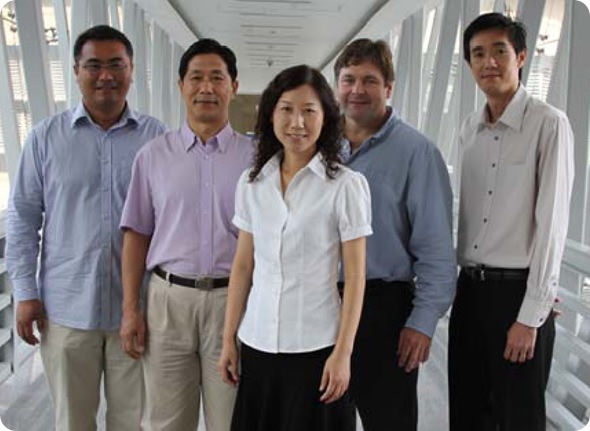A nanoparticle that can destroy drug-resistant bacteria developed by the Institute of Bioengineering and Nanotechnology (IBN), and the IBM Almaden Research Center, has recently been named one of 10 world changing ideas by Scientific American in its Technology Special Report ('World Changing Ideas – 10 New Technologies That Will Make a Difference', December 2011).

The Research Team (from left to right): Dr Chuan Yang, IBN Research Scientist, Dr Shujun Gao, IBN Research Officer, Dr Yiyan Yang, IBN Group Leader, Dr James L. Hedrick (IBM Almaden Research Center), and Dr Jeremy Tan, IBN Research Scientist.
Published in Nature Chemistry, this nanomedicine breakthrough works against drug-resistant and infectious diseases such as Methicillin-resistant Staphylococcus aureus (MRSA) and vancomycin-resistant Enterococcus. The nanoparticles are physically drawn towards the harmful bacteria in the body like a magnet, and can prevent drug resistance by tearing down the bacterial cell wall and membrane. This mode of attack is fundamentally different from antibiotics and could be a new weapon against superbugs. The nanoparticles can be infused into consumer products such as gels, sprays and lotions or formulated to treat MRSA-induced blood stream and skin infections.
Professor Jackie Y. Ying, IBN Executive Director, said, “We are delighted that Scientific American recognizes our nanoparticle discovery as a world changing idea. IBN strives to make a difference with our technologies by offering an alternative treatment solution to common diseases and illnesses. This is an excellent affirmation of our nanotechnology research against drug-resistant bacteria and we will now be focusing on developing these nanoparticles for clinical and consumer applications.”
References:
1. F. Nederberg, Y. Zhang, J. P. K. Tan, K. Xu, H. Wang, C. Yang, S. Gao, X. D. Guo, K. Fukushima, L. J. Li, J. L. Hedrick and Y. Y. Yang, “Biodegradable Nanostructures with Selective Lysis of Microbial Membranes,” Nature Chemistry, 3 (2011) 409-414.
2. Y. Qiao, C. Yang, D. J. Coady, Z. Y. Ong, J. L. Hedrick and Y. Y. Yang, “Highly Dynamic Biodegradable Micelles Capable of Lysing Gram-Positive and Gram-Negative Bacterial Membrane,” Biomaterials, 33 (2012) 1146-1153.